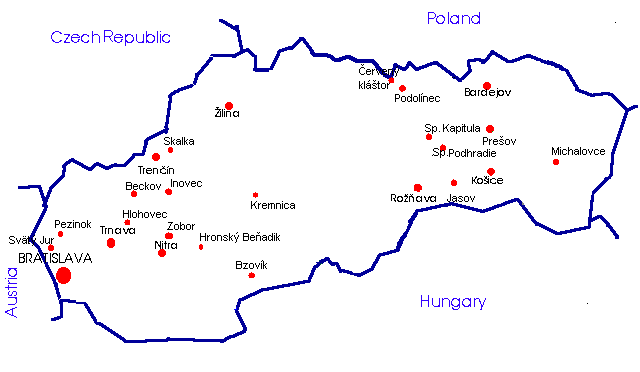

Short History of Monasteries and Orders in Slovakia
|
Monasteries and orders have a long tradition and hard history in Slovakia.They were mostly built in the Middle Ages (Romanesque and Gothic monasteries) and in the period of Counter-Reformation (16-18 centuries,especially Baroque ones).Baroque monasteries differed from the Middle-Aged ones by their luxury and size.They looked like aristocratic residences. One of the oldest monasteries was built on the hill Zobor near Nitra(around 1000). The oldest order in Slovakia were the Benedictines.In 1143 a new Benedictine Abbey of the Virgin Mary was established in Krásna pri Košiciach by the Abov nobles.It was consecrated in the same year by Jager bishop Martírius. Monasteries of the same type were founded in Jánošovce(Rimavské Janovce) and Lekír (today's Hronovce).They were so-called Feudalist funeral monasteries, the main sense of which was to care of salvation of souls of the founders and their close relatives. In their crypts the monks prayed and served requiems. First monasteries were very small, only 10-15 monks could live in them. Around the year 1130 magnate Lampert from the Hunts'stock together with his son Mikuláš founded the Benedictine Monastery of St.Štefan, the King, in Bzovík. The order of Cistercians originated from Benedictines' ideals. It was founded by Róbert of Molesme in 1098 in Citeaux.In Slovakia their communities were situated in Bardejov(1247) and Spišský Štiavnik(1223).The founder of this new order, the French abbot, prescribed them strict poverty. Manual work also played an important role in their life. That is why the Cistercians helped to develop economy. They fertilized wasteland, cleared forests and develop a special art of building. Cistercian nuns had their convent in Bratislava from 1125 until the last quarter of 13th century. They were changed by the Clarists in 1297. The next order-the Premonstratensians concentrated in Bzovík(1135), Leles(1181), Jasov(the end of 12th century), Šahy(1238), Kláštor pod Znievom(1251), Nižná Myšľa(1288). They changed the former Benedictine order. They wanted to restore declining monastic life in monasteries. They devoted themselves to pastoral work, preaching and science. They were excellent builders and except their own monastic objects they built parish churches and chapels. They also paid attention to proper education of the members of the order. Augustians' monasteries were in Veľký Šariš(1270), Svätý Jur(1279), Nové mesto nad Váhom(1310), Spišské Podhradie(1327), Hrabkov(1334), Bardejov(1380). The Carthousians came to Slovakia in 1299 and built their monastery on Skala útočišťa (the Rock of Refuge) near Letanovce. It was an inaccessible place where , according to the legend, the Saxons from Spiš saved themselves in the times of Tartar invasion. They also built Červený Kláštor(the Red Monastery) in Lechnica pri Dunajci(1319). In1543 the monastery on Skala útočišťa was pulled down as there was a possibility that it could become a suitable place for marauding knights. Castle captain Matej Bašo from Muráň attacted it, plundered it and wanted to change it into a military object. The Carmelites settled in Prešov(1288). The Augustians changed into the Guardians of the Holy Sepulchre and settled in Chmeľov(1212), later they moved to Lendak and Huncovce(1232). The Antonits had their monastery and hospital in Dravce and Bratislava. The Benedictines, Premonstratensians, Cistercians, Carthonsians, Augustians and some others belonged to contemplative orders. In addition to their spiritual service, they also re-wrote codexes, they were teachers, cultivated the ground, applied new agricultural technics, built churches etc. Since 13th century new-so called begging orders - appeared. They were the Franciscans and the Dominicans and their aim was to act actively among the inhabitants of the towns. The Clarists, the female order of the Franciscans, had their convents in Bratislava (till the end of 13th century), Trnava(1239), Kežmarok. The monasteries of the order of Paulins were situated in Letanovce(1369), Marianka(1377), Beckov(1430), Trebišov(1504) and Trnava(1650). In 14th and 15th centuries new monasteries of older orders came into being. During the reformation most of monasteries were closed. They were renewed in the time of Re-Catholisation. New orders came to Slovakia, e.g. the Paulans had their monastery in Šamorín(1690), the Trinitarians in Bratislava, Trnava, Ilava(17th century). The Jesuits headed the Catholic Counter-Reformation. The Piarists(founded in 1621) dedicated themselves to education. Their monasteries were in Podolínec(1642), Prievidza(1666), Nitra(1701), Trenčín(1776), Banská Štiavnica(1774). After the reformation there arose new monasteries of the Capuchins in Pezinok(1674), Bratislava(1676), Holíč(1750), monasteries of Merciful Brothers in Spišské Podhradie, Bratislava, Skalica, convents of Ursulines in Bratislava(1676), Košice(1698),Trnava(1724), Modra(1907). Most of begging and contemplative orders were abolished by Joseph II in 1787. Some of them were restored after his death. In 19th century modern orders appeared. They did not build monasteries of classical type. They were, for example, the Salesians, Redemptorists, Salvatorians, Verbists. Orders played an important role in culture and education, especially in the time when clergymen were the only people who could read and write. In former Czechoslovakia "the black date" for monasteries was the year 1950 when all of them were abolished, friars and nuns were interned and many valuable cultural and artistic monuments were destroyed or appropriated. The restoration began after the "velvet" revolution in 1989. |